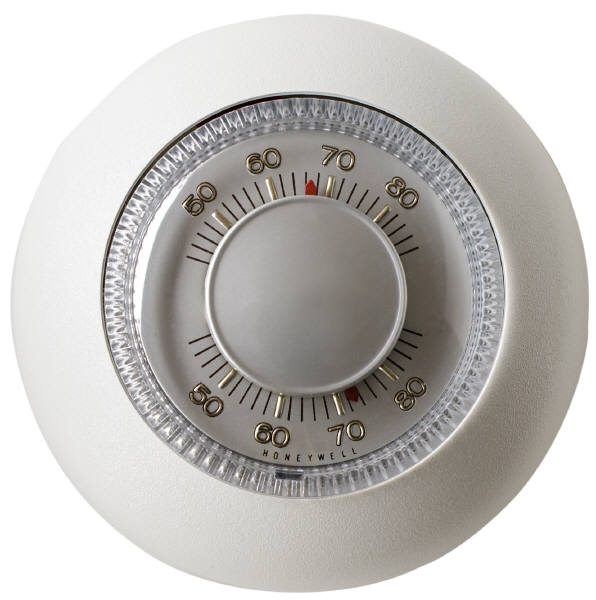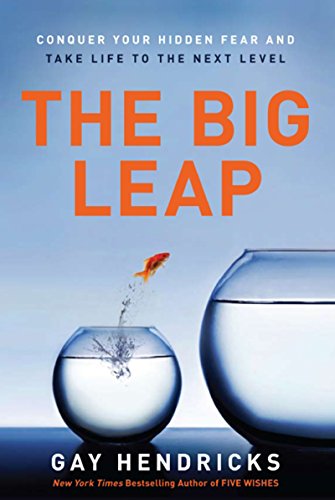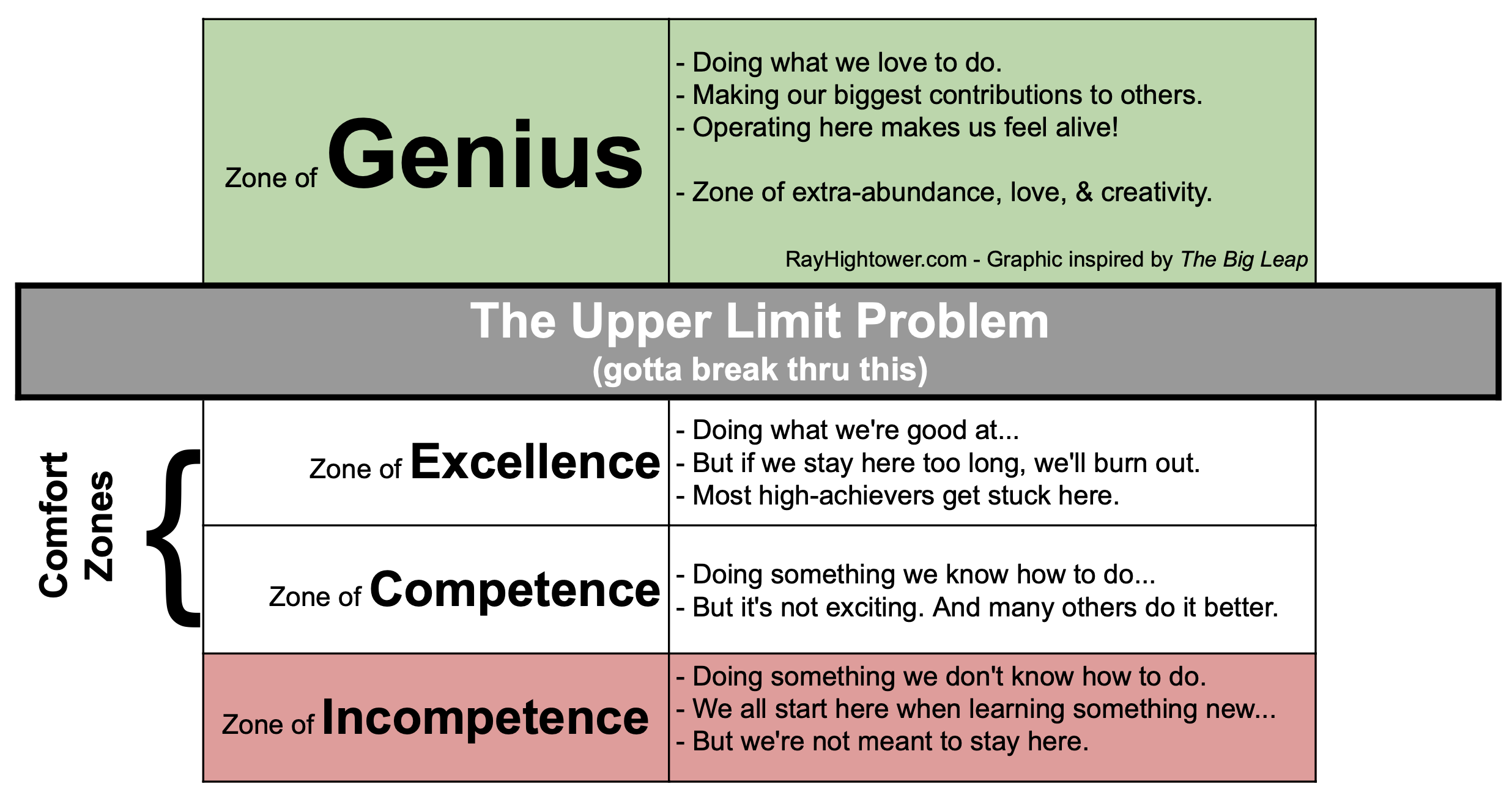Solving the Upper Limit Problem
14 Nov 2022What is stopping you from operating in your Zone of Genius? In his book The Big Leap, author Gay Hendricks identifies “The Upper Limit Problem” as the one obstacle blocking a person from achieving greatness. Hendricks divides human performance into four zones: Genius, Excellence, Competence, and Incompetence. His book inspired me to create this graphic:
The Upper Limit Problem can keep a person stuck in one of the comfort zones, never to achieve genius.
Now that we’ve outlined the problem, how can high achievers break through and achieve their potential?
ULP: Youthful Definition
Hendricks holds a PhD in psychology. He has studied human behavior for decades. He openly discusses his observations with his family, including the youngest members. His 12-year-old granddaughter explains the upper limit problem in these words:
If you don’t know it’s OK to feel good and have a good time, you’ll do something to mess up when things are going well.
Brief and clear. One could say that the upper limit problem is a form of self-sabotage.
Internal Thermostat

Hendricks has observed that we humans are equipped with an internal “thermostat” that sets an upper limit on our performance. When we produce better results than we believe we deserve, the thermostat kicks in and we engage in self-sabotage. We pull our performance back down to the “acceptable” level set by the thermostat. The thermostat controls our performance.
For most of us, the thermostat level was set in early childhood, long before we learned to think for ourselves. Teachers, parents, kids on the schoolyard, authority figures, co-workers, peers… all have a role in setting our early thermostat. Most of us live with that initial (limited) setting for the rest of our lives.
Fortunately, once we know that the thermostat exists, we can take action.
Humanity’s Upper Limit
Once Hendricks discovered a pattern for the upper limit problem, he began to see its manifestations everywhere. We can even see the upper limit problem played out on a global scale. For example:
- Humans enjoy a period of peace and then plunge into a war.
- Humans create a time of economic expansion, then we go into a recession or depression.
Back and forth, back and forth. Any time we reach a high performance level, we pull ourselves back to an “acceptable” level. To paraphrase Hendricks’ granddaughter, we have a limited tolerance for feeling good, so we do something to mess it up.
Why We Have an Upper Limit

Many of our fears are based on the workings of the ego, the part of us that’s focused on getting recognition and protecting us from social ostracism.
~From The Big Leap
Why do humans have an Upper Limit Problem in the first place, and how does having an upper limit serve us?
Having an upper limit prevents us from straying too far away from the larger group of humans. Throughout human history, we have relied on group strength for our survival.
Of all the living creatures on Planet Earth, humans are not the fastest or the strongest. But we are the best at cooperating via communication. We’re the best at working together in groups. Even in the present day, each of us depends on the group for our survival. We depend on each other for food, shelter, medical care, and protection from outside dangers.
What happens to a human who separates from the group? For our earliest ancestors, separation meant death. Therefore, we’ve evolved to value group cohesion. Sticking with the group is literally a matter of life or death.
Group cohesion is driven by our desire to survive. Therefore, when we try to achieve beyond (outside of) the group, the internal voice of fear (Upper Limit Problem) prods us to get back in line. To get back to the comfort zone, where it’s safe.
Examples of ULP Management Success
Hendricks cites some examples of people who successfully identified their upper limit problem. They learned how to conquer it and thereby operate within their Zone of Genius.
- Dr Robert Jordan. Jordan had the opportunity to sell his company for a large financial gain, and then blew up the deal over a minor issue that turned into a big argument. Jordan recognized that his upper limit problem had kicked in, causing him to self-sabotage the deal. After that loss, he learned to manage his upper limit problem by asking himself two questions:
- How much love and abundance am I willing to allow?
- How am I getting in my own way?
- Kenny Loggins, musician. Hendricks has served as on-the-road coach for Loggins and his band. Loggins’ upper limit problem showed itself every time he had a hit record or won a Grammy. After every success, he would get sick, ruin a relationship, or perform some other act of self-sabotage. Loggins’ initially isolated his upper limit problem through meditation. This led to a new level of performance within his Zone of Genius.
Not “One and Done”
Note that solving the Upper Limit Problem is not a “one and done” action. Every day, the Upper Limit Problem will strive to pull us back in line, to pull us back within the larger group of humans. As high achievers, it’s up to us to recognize the ULP and deal with it. Every day.
Conclusion + Next Steps
One final point. Hendricks observes that the more a person achieves, the more urgent it is for them to identify and overcome their Upper Limit Problem. Your fellow humans are waiting for you to operate in your Zone of Genius; everyone benefits when you do.
Now that you’ve read this discussion of the Upper Limit Problem, I encourage you to read the book The Big Leap. The author describes the problem in greater detail, and he offers some solutions that might serve you well.




